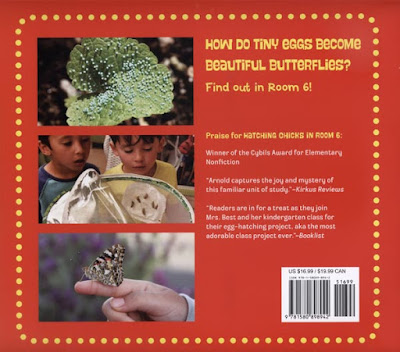In the June 12, 2024 post in the Toot Your Horn section of the Kite Tales blog, is the announcement of my new memoir, SETTLEMENT HOUSE GIRL: Growing Up in the 1950s at North East Neighborhood House, Minneapolis, Minnesota, along with new books by seven other SCBWI members. Hurray! I have been a member of SCBWI since 1977. Kite Tales is the newsletter and blog of the Los Angeles, Southern California, and Central California branches. I'm proud to share the news of my book
Saturday, July 20, 2024
TOOT YOUR HORN! for SETTLEMENT HOUSE GIRL in SCBWI's Kite Tales
In the June 12, 2024 post in the Toot Your Horn section of the Kite Tales blog, is the announcement of my new memoir, SETTLEMENT HOUSE GIRL: Growing Up in the 1950s at North East Neighborhood House, Minneapolis, Minnesota, along with new books by seven other SCBWI members. Hurray! I have been a member of SCBWI since 1977. Kite Tales is the newsletter and blog of the Los Angeles, Southern California, and Central California branches. I'm proud to share the news of my book
Thursday, November 23, 2023
15th BLOG ANNIVERSARY: Time to Celebrate!
Fifteen years ago, in November 2008, I launched this blog. At first my plan was to use it to feature my art, which is why the link is carolinearnoldart. But a little more than a year later I decided to expand the blog to include my writing as well and changed the name to Caroline Arnold Art and Books (the link is still carolinearnoldart) with the plan of putting up a new post once a week. (Typically the posts go up on a Wednesday or Saturday--some weeks there are two.)
For me, this blog is a way to keep track of my book and art related activities, including school and library visits, publishing, reviews, activities for children and teachers, announcements of prizes and awards and more. Since launching the blog I have posted more than 800 items that have been viewed by more than 330,000 visitors!
Thanks to all of you who have been following this blog either on Google or by email. I appreciate your support.
(Note: The Comments section is no longer active. If you would like to comment you can reach me at Facebook or by email.)
Thursday, September 7, 2023
INTERVIEW WITH DEBORAH KALB about MY FRIEND FROM OUTER SPACE
I was pleased to be interviewed by journalist Deborah Kalb about my new book MY FRIEND FROM OUTER SPACE. She has posted it on her blog Book Q&As with Deborah Kalb this week. Deborah Kalb interviews a lot of authors and I am happy to join the list. It is always good to have more publicity! Thank you Deborah!
Here are the questions she asked me. Check out her blog for the answers!
Deborah Kalb is a freelance writer and editor. She spent about two decades working as a journalist in Washington, D.C., for news organizations including Gannett News Service, Congressional Quarterly, U.S. News & World Report, and The Hill, mostly covering Congress and politics. Her book blog, Book Q&As with Deborah Kalb, which she started in 2012, features hundreds of interviews she has conducted with a wide variety of authors.
Deborah's newest book is Off to Join the Circus.
Wednesday, December 14, 2022
SHARING NATURE WITH CHILDREN, Blog by Children's Book Author Carolyn Combs
With many thanks to Carolyn Combs for sharing my book HATCHING CHICKS IN ROOM 6 on her blog, Sharing Nature With Children. It is one of more than a dozen books about animals and nature recommended in time for holiday purchase. Find it in hardcover and as a Kindle on Amazon.
Carolyn Combs is the author of WHAT'S THIS TAIL SAYING? (Dawn Publications, 2020).
Thursday, May 26, 2022
INTERVIEW WITH DEBORAH KALB about KEEPER OF THE LIGHT and PLANTING A GARDEN IN ROOM 6
I was pleased to be interviewed by journalist Deborah Kalb about my new books. She has posted it on her blog Book Q&As with Deborah Kalb this week. Most of the interview is about KEEPER OF THE LIGHT although, at the end, I also comment briefly on my other new book, PLANTING A GARDEN IN ROOM 6.
Deborah Kalb is a freelance writer and editor. She spent about two decades working as a journalist in Washington, D.C., for news organizations including Gannett News Service, Congressional Quarterly, U.S. News & World Report, and The Hill, mostly covering Congress and politics. Her book blog, Book Q&As with Deborah Kalb, which she started in 2012, features hundreds of interviews she has conducted with a wide variety of authors.
She is the author of the new children’s book The President and Me: John Adams and the Magic Bobblehead (Schiffer, 2018), the second in a series — after The President and Me: George Washington and the Magic Hat (Schiffer, 2016) — and the co-author, with her father, Marvin Kalb, of Haunting Legacy: Vietnam and the American Presidency from Ford to Obama (Brookings, 2011). She is the editor of the new two-volume reference book, Guide to U.S. Elections, 7th edition (CQ Press/SAGE, 2016), the co-author of The Presidents, First Ladies, and Vice Presidents (CQ Press, 2009), and the co-editor of State of the Union: Presidential Rhetoric from Woodrow Wilson to George W. Bush (CQ Press, 2007), and has contributed updates to a variety of CQ Press books on politics and government.
Saturday, April 30, 2022
REVIEW OF PLANTING A GARDEN IN ROOM 6 at THE NONFICTION DETECTIVES
I was delighted to discover PLANTING A GARDEN IN ROOM 6: From Seeds to Salad reviewed on THE NONFICTION DETECTIVES, the excellent blog by librarians Cathy Potter and Louise Capizzo. It posted on April 22, 2022, Earth Day! Thank you for helping to spread the word about my new book!Here is the review:
Planting a Garden in Room 6: From Seeds to Salad
Written and photographed by Caroline Arnold
Charlesbridge. 2022
Another addition in Arnold’s Life Cycles in Room 6 series, has this kindergarten class planting a garden. In beautiful, colored photos we follow this special teacher as she shares her love of science with her students.
This year, Kindergarten teacher, Mrs. Best, has brought some lettuce, kale, radish, spinach, carrots, and pea sees for student to plant in their classroom garden. Readers follow students as they discover each plant has it own kind of seed, preparing the soil to watching the seeds emerge. As they learn about helpful insects, weeding, and garden care the best part comes at harvest time when they can all enjoy the fruits of their labor with a yummy salad.
The book includes garden vocabulary, garden questions, online sources and suggestions for further reading. *The fun part is learning that the chickens pictures in this book are the ones hatched in Arnold’s book, Hatching Chicks in Room 6. I wish I had a Mrs. Best as my Kindergarten teacher.
Visit the author's website for more information on her books.
Wednesday, October 27, 2021
BACK TO SCHOOL WITH CHICKENS
 |
| Author Carolyn Combs blog for Sept 2021 |
Many thanks to Carolyn Combs! Check out her blog and learn about my book and four other fascinating books about chickens and their relatives!
Saturday, October 10, 2020
LITLINKS GUEST POST: Kids See Chicks Hatch With Their Own Eyes
This article first appeared on September 16, 2020, as a guest post at Patricia Newman's blog, LitLinks, Authors, Educators, Scientists sharing the natural connections between STEM and Language Arts.
Life Cycle Reinforces Reading:

Among the many lessons learned in HATCHING CHICKS IN ROOM 6 is the life cycle process–from incubating the eggs, seeing the shells break open, to watching the chicks grow from fluffy balls to fully feathered chickens. It is one thing to be told that chicks grow in eggs, but another to actually see an egg hatch with your own eyes. This photo essay follows an egg from the time it is laid in the henhouse, through the incubating and hatching process in a school classroom, to the time when the chicks are ready to go back to the flock. Children observe the eggs and chicks up close as they learn firsthand about a chicken’s life cycle.
Strategies for reading Hatching Chicks in Room 6:
Main text: The text of HATCHING CHICKS IN ROOM 6 is written on two levels—the main narrative, printed in larger type, and sidebars, printed in smaller type. Headings are red and in capital letters for emphasis. What is the effect of telling the story in the present tense? Does it make you feel as if you are participating in the process?
Sidebars and captions: The sidebars and captions add information, provide the opportunity to introduce more difficult vocabulary, and expand on material in the main text. Note that the sidebars are printed over a photo of an egg, reinforcing the theme of the book.
Photos: “Reading” the photos is an important part of understanding the book. Photos:
- Add information to the story (such as showing what an incubator looks like),
- Show the children in their environment (in the classroom and outside in the chicken pen),
- Provide a sense of scale (we see the size of a newly hatched chick as it rests in a child’s hand), and
- Enlarge details for a closer look (the parts of a chick’s body).
- The photos also reveal the children’s emotional response to the chicks. We see and share their sense of wonder as they participate in each step of the process.
Hands-on: How many days to hatch a chick?
The events of the story in HATCHING CHICKS IN ROOM 6 occur in chronological order. You can use these events to create a time line, beginning with the day the eggs go into the incubator. Click HERE for a downloadable coloring page.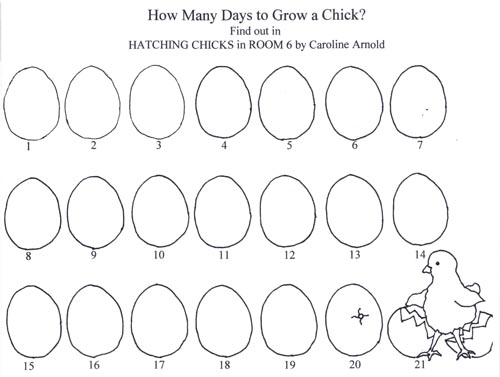
Which came first, the chicken or the egg?
In one classroom of second graders, the children made a mixed media presentation to show the life cycle of a chicken. They used packing material to represent the chicken’s nest, real feathers to represent the growing chick, a hand-print for the body of an adult chicken, markers for drawing, and googly eyes for all. Mounted on a large poster board cut into an egg shape, with black arrows drawn to indicate the circular process, it is a dramatic and colorful presentation.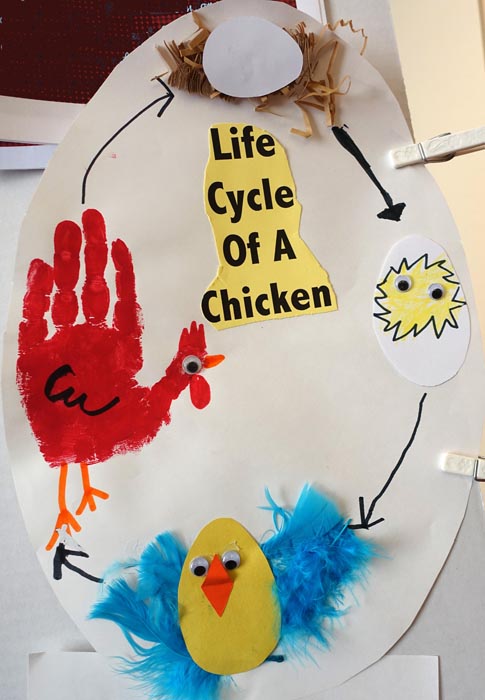
Ready to hatch!
When a chick is ready to hatch, it uses its beak to poke a hole in the shell.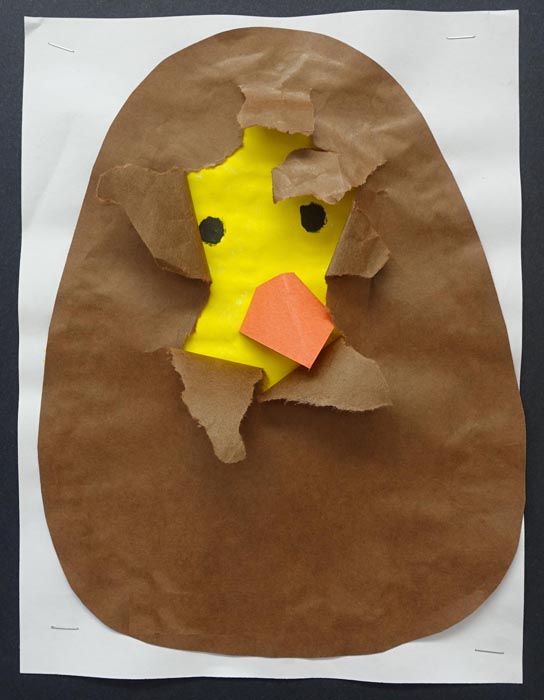
1. Cut out two large egg shapes from yellow and brown paper. Cut a small hole in the middle of the brown paper. Glue the egg shapes together around the edges.
2. Carefully tear back the hole in the brown paper, pulling the pieces to reveal the yellow paper underneath.
3. Use a marker to draw two black eyes. Cut a triangle of orange paper and fold in half to make a beak. Glue it on.
Now your chick looks like it is ready to hatch!
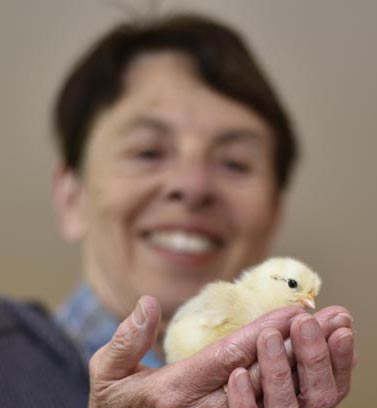
Wednesday, February 12, 2020
10 YEAR BLOG ANNIVERSARY
For me, this blog is a way to keep track of my book and art related activities, including school and library visits, publishing, reviews, activities for children and teachers, announcements of prizes and awards and more. Since January 2010 I have posted more than 500 items that have been viewed by more than 200,000 visitors!
Thank you to all of you who have been following this blog either on Google or by email. I appreciate your support.
Wednesday, August 28, 2019
STEM LitLinks for BUTTERFLIES IN ROOM 6 at Patricia Newman's Blog
Thanks Patricia for the opportunity to contribute to your terrific site!
Wednesday, July 17, 2019
Review of BUTTERFLIES IN ROOM 6 at the Mom Read It Blog
Mom Read It (blog) March 7, 2019
Spring is getting closer and closer, and that means that science classrooms all over the place are going to introduce their little ones to the life cycle of a caterpillar/butterfly. We’ve done it in my home, and each of my kids has done it in school, and it’s exciting every time. Butterflies in Room 6 revisits the Kindergarten students of Room 6 – a new group, since Hatching Chicks in Room 6 was published in 2017 – as they raise butterflies, starting from teeny, tiny caterpillar eggs.
Full-color photographs and informative text take this STEM/STEAM story through the step-by-step process by which the class observed and cared for their caterpillars; feeding them, observing the stages of life, moving the chrysalises to a larger, netted environment, the exciting emergence of the painted lady butterflies from their cocoons, and their release into the world! Leaf-shaped callouts throughout the book provide additional caterpillar and butterfly facts, and back matter provides butterfly questions, vocabulary, and a nice list of online and print resources for further reading.
Butterflies in Room 6 brings a real-world look into a primary classroom – it’ll get kids excited about science, especially if this is one of your classroom projects. Pair this with The Very Hungry Caterpillar and the classic that my kids all read in their kindergarten classes, Deborah Heiligman’s From Caterpillar to Butterfly.
By Librarian Rosemary Kiliditas
Wednesday, July 3, 2019
Review and Interview with Ronna Mandel of BUTTERFLIES IN ROOM 6
Caroline Arnold’s new nonfiction picture book, Butterflies in Room 6, is both an educational and enjoyable read. Its release last week could not have been more timely, especially for those of us living in SoCal who have been privy to a rare treat of nature.
“Those black-and-orange insects that seem to be everywhere you look in Southern California aren’t monarchs and they aren’t moths. They are called painted ladies, and these butterflies are migrating by the millions across the state,” says Deborah Netburn in a March 12 Los Angeles Times article.
If Butterflies in Room 6 doesn’t make you want to head back to Kindergarten, I don’t know what will. Arnold takes us into Mrs. Best’s classroom to witness first hand the amazing life cycle of a painted lady butterfly. Colorful and crisp photographs fill the the book and are most impressive when they accompany all four stages of this butterfly’s brief but beautiful life. The first stage is an egg. The second stage is a larva also know as a caterpillar. Following this is the pupa and third stage when the metamorphosis occurs that transforms the pupa into a butterfly. The forth or last stage is when the butterfly emerges as an adult and the cycle will begin again.
A host of illuminating facts are shared in easy-to-understand language complemented by Arnold’s fab photos. Helpful notations on each picture explains the process depicted. Seeing the faces of the delighted children engaged in Mrs. Best’s butterfly project is certain to excite young readers who may also be planning to participate in this “common springtime curriculum activity.” If there is no project on the horizon, this book (coupled with a video recommended in the back matter) is definitely the next best thing.
Obviously a lot goes into raising butterflies and Arnold provides step by step details so anyone thinking about this will know exactly what’s involved. Pictures illustrate the process from preparing the eggs sent via mail, to leaving food for the soon-to-be caterpillars and then shifting their environment to one that is ready for the pupa stage before moving the chrysalis (thin shell) covered pupa into a special “flight cage” that resembles a clear pop-up laundry basket. Ultimately butterflies emerge. This particular part of Butterflies in Room 6 will thrill every reader who has vicariously followed along with the class’s journey. When Mrs. Best allows each child to hold a butterfly before they fly away, whether to a nearby flower or to find a mate, the reader will feel a sense of joy at having been privy to this unique experience. I know I was!
The book contains enlightening back matter including “Butterfly Questions,” “Butterfly Vocabulary,” “Butterflies Online,” “Further Reading” and “Acknowledgements.” Arnold must have read my mind when she answered my question about the red stains on the side of the flight cage. Turns out they are due to the red liquid called meconium, “left over from metamorphosis.”
While the book should certainly find a welcome place on the shelves of schools and libraries, I also hope it will find its way into homes across the country so families can share in the wonder and delight of butterflies that Arnold’s words and photos perfectly convey.
INTERVIEW WITH CAROLINE ARNOLD
GoodReadsWithRonna: First there was Hatching Chicks in Room 6 and now there’s Butterflies in Room 6. What was the history of how this second book came to be?
Caroline Arnold: Several years ago, when I was doing an author visit at Haynes school in Los Angeles, I met Jennifer Best, a kindergarten teacher. Each spring, her students learn about life cycles. Two years ago I spent time in her classroom while they were hatching chicken eggs in an incubator. That resulted in my book Hatching Chicks in Room 6. At the same time, the class was also raising Painted Lady butterflies from caterpillars–watching the caterpillars grow in a jar, turn into chrysalises, and, after a week or so, emerge as beautiful butterflies. It seemed like the perfect sequel to Hatching Chicks in Room 6.
GRWR: Your photos are wonderful. How difficult is it photographing elementary school children whose awe at the butterfly project you capture so well? And the subject themselves – the images of the butterfly emerging from the chrysalis are an eye-opener! How hard was this?
CA: As with the book about chicks, I realized that the best way to tell this story was with photographs. I embedded myself in Jennifer Best’s classroom, which enabled me to follow the process along with the children and get the photos I needed. A challenge was that neither the children nor butterflies stayed still for long! My secret was to take LOTS of pictures. The story takes place in real time, so I had to get the photos I needed as they happened. There was no going backwards. For the close-up photos I raised butterflies at home. Even so, catching a butterfly emerging from its chrysalis isn’t easy. The whole process only lasts about a minute, so I had to watch constantly to catch it in time. And no matter how many times I watched a butterfly come out, it was always miraculous.
GRWR: Where do you go to enjoy nature in L.A.?
CA: I am a bird watcher and like to go for walks on the beach and watch sandpipers and other shorebirds skitter at the edge of the waves or pelicans flying in formation. I also enjoy walks on the path along Ballona Lagoon in the Marina, another great place for birdwatching. But, one of the best places to enjoy nature is my own backyard and my neighborhood near Rancho Park. Ever since writing Butterflies in Room 6 I have been much more aware of the variety of butterflies that one can see in Los Angeles—monarchs, swallowtails, painted ladies, white and yellow sulphurs, and many more. Last year I bought a milkweed plant for my garden and was delighted to discover several weeks later monarch caterpillars happily eating the leaves. A surprising amount of nature is around us all the time—we just have to look!
Thursday, November 23, 2017
Celebrating Nine Years at CAROLINE ARNOLD ART AND BOOKS
Happy Thanksgiving! Today is the ninth anniversary of my first post on this blog, an announcement of my new art prints at Etsy.
Thanks for visiting!
If you haven't signed up to receive the blog by email, consider it! It will be delivered each week to your mailbox.
Wednesday, September 20, 2017
FICTION versus NONFICTION: What Do Young Children Prefer?
Mohr, Kathleen A. J. “Children’s Choices for Recreational Reading: A Three-Part Investigation of Selection Preferences, Rationales, and Processes.” Journal of Literacy Research, 2006, p. 81-104.
Wednesday, May 10, 2017
TEACHING IDEAS for Hatching Chicks in Room 6 at the SLJ Classroom Bookshelf
Erika Thulin Dawes is a former classroom teacher, reading specialist, and literacy supervisor, she now teaches courses in children’s literature, early literacy, and literacy methods.
Saturday, February 18, 2017
Hatching Chicks and Living Fossils at Kite Tales Blog
Thanks SCBWI!
Monday, October 3, 2016
CELEBRATING 100,000 PAGE VIEWS of Caroline Arnold Art and Books
Wednesday, August 3, 2016
SCBWI SUMMER CONFERENCE 2016, Los Angeles, CA
 |
| My Workshop at the 45th Annual SCBWI Summer Conference, Los Angeles, CA |
 |
| Book Sale and Stairway to the Biltmore Bowl |
 |
| Some of the many SCBWI nonfiction writers at the Nonfiction Social |
 |
| Lin Oliver, our extraordinary leader and co-founder of SCBWI |
 |
| Book Signing in Crystal Ballroom |
 |
| Chocolate pyramid dessert at Golden Kite Awards Dinner |
Wednesday, January 20, 2016
BLOG ROLL: Thanks, SCBWI, for Featuring my Blog!
Take a look and check out all the great blogs!
Saturday, January 9, 2016
Tips for Conquering Writer’s Block, at Author Joanne Rocklin’s Blog
My book A Guide Dog Puppy Grows Up tells how dogs are trained to work with blind people by following one puppy from birth to graduation. My first manuscript had all the facts but seemed to be missing something. Then my editor suggested changing the tense from the past to the present. I did and suddenly the story came alive, making us feel as if we are participating in the action. So, if you are stuck in your story, take a look at the tense and see if changing it makes us see your story in a new light.
Go to Joanne’s website. You will find lots of other tips and information about Joanne’s wonderful, award winning books. Her most recent title is I SAY SHEHECHIYANU, illustrated by Monika Filipina, a beautiful picture book suitable for all Jewish festivities, celebrations, and the proud “first times” of childhood.
















